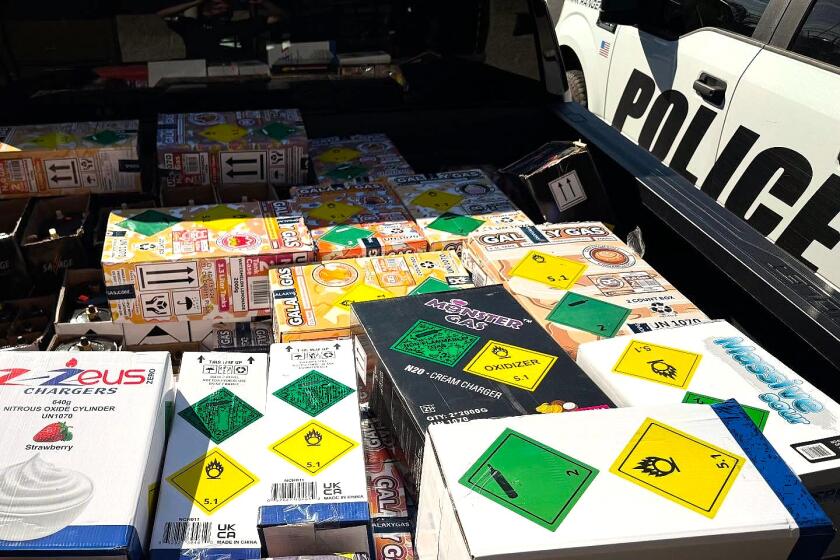Two turntables and a microphone
- Share via
EDITOR’S NOTE: This is part three in a six-part series that takes a look at the local music scene.
COSTA MESA — Last year, the Growlers pieced apart their recording studio in Westminster, packed it all into the backs of cars and headed for a nondescript office building on the Westside. The studio, which they dubbed the Ratlands — a popular 1960s counterculture name for the seedy side of Mexico — had taken more than one trip in the past. The band left its initial digs in Long Beach when the neighborhood grew too violent, then left Westminster when the property they had been renting went into foreclosure.
Once in Costa Mesa, the band broke out its toolbox and set to work fitting the Ratlands into a space slightly smaller than the last one. The room on Superior Avenue wasn’t a perfect square, so the members sawed off five feet from one of the walls. The ceiling had caved in slightly, but that didn’t turn out to be a problem for acoustics. With their new home secured, the Growlers set to work on decoration, hanging a makeshift BB gun range from the ceiling, stringing Christmas lights around the bar area and plugging in a pair of tape machines — one two-track, one 24-track — that both date from circa 1980.
The machines may be old, but they aren’t meant as museum pieces. The Growlers — who released their first CD, optimistically titled “The Growlers’ Greatest Hits,” on iTunes last year — installed the equipment to capture an old-fashioned vibe on their recordings. In the age of digital recording, some artists still believe tape produces a warmer sound, and a number of them knock on the Ratlands’ door to set up a session.
“I think anyone in the rock ’n’ roll business who knows what they’re doing chooses to do it on tape,” said Brooks Nielsen, the Growlers’ lead singer. “The old bands they’re listening to that they love, that’s how it was recorded.”
For under-the-radar musicians, the process of making a CD can be an offbeat and unpredictable one.
Some artists shell out thousands of dollars to have their songs preserved by professionals; others rely on friends who donate their equipment for free. If the person at the controls is skilled enough, the listener may not be able to tell the difference.
“Anyone can buy an Apple computer and set up a studio in their garage,” said singer-songwriter Vanessa Jourdan, who has recorded in a sewing shop and a warehouse, among other places.
The central Orange County area contains a number of professional venues for recording, including the Ratlands and Woodland Bredice Studios in Irvine, which counts Corona del Mar roots-rocker Ryan Strassburg and other Newport-Mesans among its clientele. eVocal, a boutique and gallery on the Westside, operates a studio that doubles as a garment factory to create bands’ promotional clothing (see full story on Saturday).
Just as easily, though, state-of-the-art recordings can come out of a studio with a lawn and a mailbox in front. The pop-reggae band Dominion Status, led by Costa Mesa paralegal Dereck Blackman — whose father, Garfield Blackman (a.k.a. Ras Shorty I, the Father of Soca and the Love Man), was a superstar in his native Trinidad — works out of a spare bedroom in the home of producer and drummer Josh Schreiber, who fits amplifiers, drums and a mixing board in between the bed and bookcases.
How much does it cost to rig up a home recording studio? According to Don Solo, the general manager of Jim’s Music Center in Irvine, the answer seems to get lower every year. The cheapest option, he said, is to buy computer software that has a recording program — typical cost: about $99 — although a quality stand-alone recorder, which comes with a mixing board and even a CD burner, usually retails for about $500. The sophistication of the equipment, he added, rarely ends up being the key factor.
“You need talent,” said Solo, who has worked at Jim’s for a decade. “I don’t sell that.”
Richard Bredice, the co-owner of Woodland Bredice Studios, said even with top-of-the-line digital equipment, acoustics still play a large part in the sound of a recording. He often gets requests to mix homemade tracks and can sometimes visualize the recording room by listening closely.
“You can hear the ceilings,” he said. “You can hear the dry wall. It’s not pro. That’s the downside. But a lot of guys who are savvy will treat those rooms to minimize the effect they have on the sound.”
Nielsen, who lives near the Ratlands and repairs fountains during the day, considers himself lucky that the new Ratlands’ acoustics worked out so well. He often spends seven nights a week recording himself and other artists, and hopes to make the studio an after-hours hangout for musicians.
One band that recently laid down tracks at the Ratlands, and profited nicely from it, was the Japanese Motors, another Costa Mesa outfit whose members are friends with the Growlers. The band, led by singer and pro surfer Alex Knost, recorded a demo at the studio that caught the interest of Die Slaughterhaus Records, a small label in Georgia. The Motors released their first single — on vinyl, no less — through the label this year and have since signed a contract with Vice Records in New York.
Knost, who grew up spinning Elvis and Beach Boys discs, credited the Ratlands’ old-fashioned style for getting label attention.
“We’ll never record straight to digital,” he said.
YOUR OWN RECORDING STUDIO
How do you build a home recording studio from scratch? It turns out you can do it any number of ways, from the simplest (a computer with a microphone) to the most elaborate (a mixing board, amps and enough space to fit your backup band between the bed and dresser). Tom Sebastian, the senior sales associate of Jim’s Music Center in Irvine, offered the following rundown on some of his store’s inventory:
To check out the Daily Pilot’s six-part series on the Newport-Mesa music scene, click here.
HOW TO MAKE YOUR OWN STUDIO
ITEM / WHAT IT DOES / COST
Mixing board / Allows you to be your own producer, mix vocals and instruments and add sound effects / $150 to $1,000
Compressor / Compresses sound and limits spikes in volume / $99 to $500 for a basic compressor; some more sophisticated models for up to $1,500
Tube pre-amp / Provides a warmer sound quality / $99 to $500 for most models
Patch bay / Serves as router for mixing board, guitars and other equipment / $99 to $200
Interface / Converts analog sound to digital sound / $150 to $250 for two sound channels, $500 to $800 for eight channels
Processor / Serves as plug-in for electric bass, guitar and other instruments / $99 to $800
Studio condenser microphone / Best for recording voices and acoustic instruments / $99 to $500
Live microphone / Best for recording electric instruments / $89 to $350
Drum machine / Provides electronic drums and sometimes bass / $99 to $500
Jim’s Music Center is at 14120 Culver Drive, Suite J in Irvine. The store can be reached at (949) 552-4280 or visited at www.jimsmusic.com.
MICHAEL MILLER may be reached at (714) 966-4617 or at [email protected].
All the latest on Orange County from Orange County.
Get our free TimesOC newsletter.
You may occasionally receive promotional content from the Daily Pilot.



